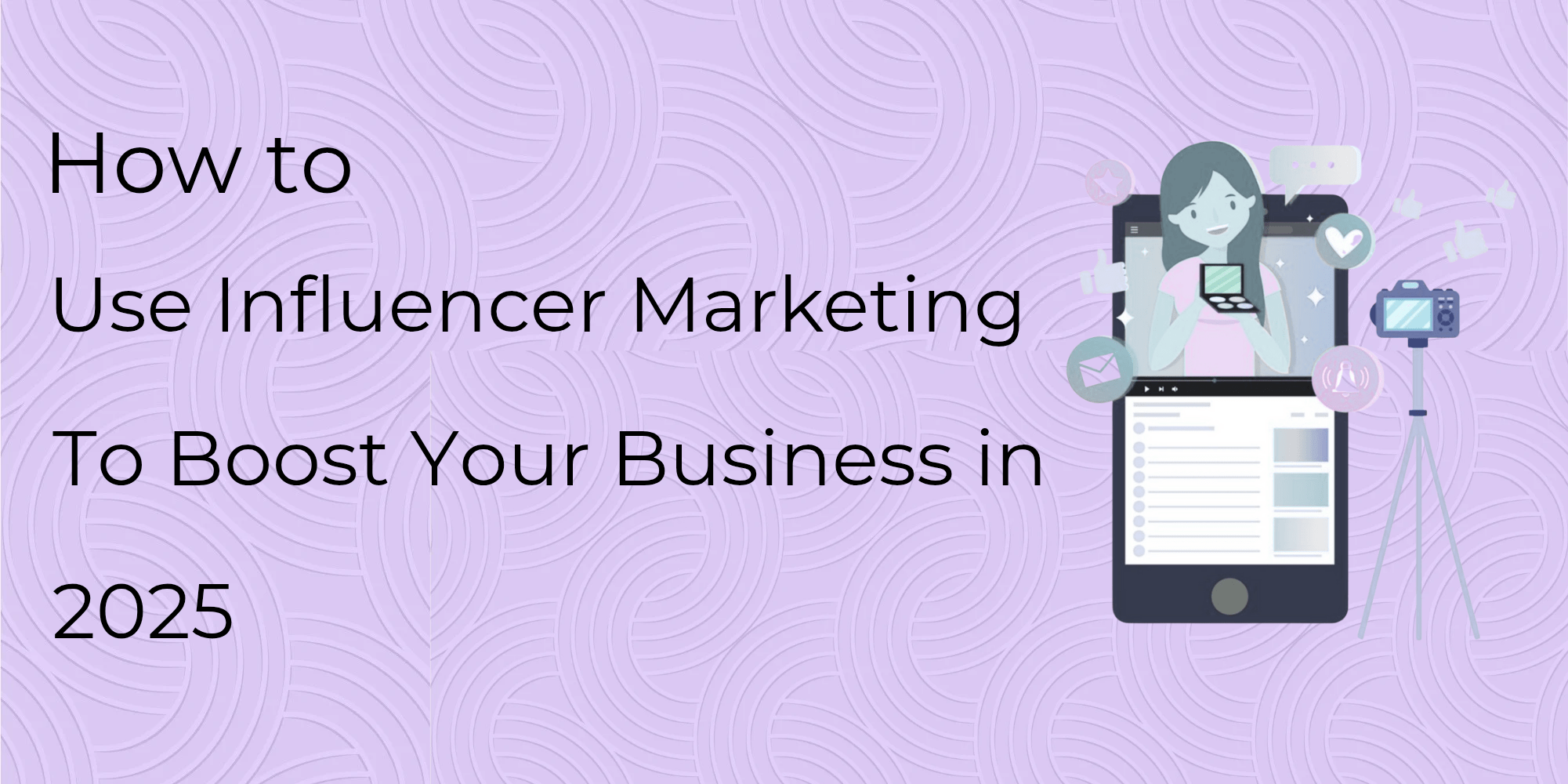Influencer marketing has changed significantly in the last decade, and in 2025, it’s stronger than ever. Social media platforms are constantly changing, and consumer trust is shifting more and more to real voices over classic ads, making it leverageable for high ROI—if executed effectively.
Whether you’re a new startup or a well-established company, learning how to leverage influencer marketing strategically in 2025 can get you brand awareness, conversion boosts, and loyal communities. Here’s what you need to know.
● Why Influencer Marketing Still Works in 2025
Even with AI-produced content and algorithm-based ad campaigns on the rise, human beings trust human beings more than they trust companies. Influencer marketing leverages that trust.
Some important facts to keep in mind:
- 61% of shoppers rely on influencer endorsements more than brand-generated content (2025 Statista survey).
- The mean ROI on influencer marketing is $5.78 for each $1 spent (2025 Influencer Marketing Hub report).
- Nano- and micro-influencers (with less than 50K followers) now generate more engagement than macro-influencers in the majority of niches.
Briefly, influencer marketing isn’t a fad—it’s a building block of contemporary digital strategy
Step 1: Define Your Goals
Prior to approaching influencers, you have to understand what you are targeting. Typical influencer marketing objectives in 2025 are:
- Brand Awareness: Exposure of your name in front of more people.
- Lead Generation: Driving registrations or inquiries.
- Sales Conversion: Direct product purchases or service bookings.
- Content Creation: Working together to create high-quality, shareable content.
- Community Building: Building loyal brand advocates.
Each objective will determine the type of influencers you collaborate with, the platform you apply, and the KPIs you measure.
Step 2: Select the Proper Type of Influencer
Influencers range in size. The correct fit depends on your objectives, niche, and budget.
✨ Types of Influencers:
TypeFollower CountBest ForProsConsNano-influencers<10KLocal targeting, niche productsHigh engagement, low costLimited reachMicro-influencers10K–50KEngagement, trust-buildingLoyal audiences, cost-effectiveWill need to partner multiple timesMid-tier influencers50K–500KProduct releases, awarenessGood reach + trust balanceReasonable costMacro-influencers500K–1MMass appeal campaignsLarge reachHigher expense, less relationalMega-influencers/Celebs1M+Branding, viralityExtensive exposureVery costly, lower engagement
Step 3: Choose the Right Platforms
Not all platforms are right for every product or audience. In 2025, the following platforms dominate influencer marketing:
- Instagram
Still ahead in lifestyle, beauty, travel, and fashion niches. Reels and stories are still dominant formats. - TikTok
Excellent for viral short-form video content—perfectly suited for Gen Z and Millennial audiences. - YouTube
Product reviews, tutorials, or deep dives thrive on long-form content. - LinkedIn
Thought leaders, B2B influencers, and professional services brands are best suited. - Twitch & Kick
Gaming, technology, and entertainment brands are progressively using live streaming platforms. - Podcasts
Niche podcasts have accumulated extremely loyal audiences—perfect for long-form brand narrative or sponsorships.
Pro tip: Leverage influencer analytics solutions such as Upfluence, AspireIQ, or CreatorIQ to determine platform metrics and select the most suitable.
Step 4: Identify Appropriate Influencers
The correct influencer is not merely about the number of followers. It’s about relevance, authenticity, and matching audience.
How to Find Influencers in 2025:
- Influencer platforms: Utilize platforms such as Heepsy, Traackr, or Brandwatch to search by niche, engagement rate, location, etc.
- Hashtag research: Look up related hashtags within your niche to discover organic creators.
- Competitor research: Find out who your competitors are partnering with.
- Social listening: Monitor mentions of your brand to discover existing champions.
What to Look For: - High rates of engagement (rather than artificially inflated follower numbers)
- Demographics of their audience that align with your target market
- Brand consistency with regards to voice, tone, and values
- Stable posting history and content quality
Step 5: Create a Strong Collaboration Offer
Shortlist influencers and approach them in a professional manner. Use DMs or email, but make it personal.
What to include:
- Who you are and what your brand is all about
- Why you believe the influencer is an awesome match
- The type of collaboration you’re offering (sponsored post, giveaway, product review, affiliate partnership, etc.)
- Offer of budget or compensation
- Timeline and what the next steps will be
Sample message:
“Hi [Name], I enjoyed your recent post on [Topic]! I’m [Your Name] from [Brand], and I believe our [Product/Service] is a perfect fit with your values and audience. We’d like to collaborate on a sponsored post—are you interested in discussing it further?”
Don’t forget: a lot of influencers in 2025 work for management teams, so be ready to negotiate.
Step 6: Choose Compensation
There are various influencer compensation models:
- Free product or service
- Flat fee per campaign or post
- Affiliate commission (performance-based)
- Long-term ambassador deals
- Pay-per-conversion (especially SaaS or e-commerce)
Rate ranges differ by platform, niche, and engagement rate. A micro-influencer may charge $100–$500 per post, while macro influencers may charge thousands.
Step 7: Monitor Performance and ROI
Measuring influencer ROI in 2025 is more analytical than ever. Here’s how to monitor success:
Shared Metrics:
- Likes, comments, shares engagement rate
- Impressions and reach
- Click-through rate (CTR)
- Conversion rate (monitored through promo codes or UTM links)
- Revenue and sales (utilize affiliate tracking or custom landing pages)
- Follower growth (yours and the influencer’s)
Use tools like Google Analytics, Bitly, Shopify Influencer Tracking, or HubSpot to monitor performance in real-time.
Step 8: Optimize & Scale
Once you’ve run a few campaigns, analyze what worked:
- Which influencers delivered the best ROI?
- What type of content performed best—videos, stories, carousels?
- Did your conversions come from one platform more than others?
Double down on what’s working. Consider turning high-performing influencers into brand ambassadors for longer-term collaboration.
● Advanced Tip: Leverage AI in Influencer Marketing
In 2025, AI technologies are assisting brands with:
- Early identification of emerging influencers
- Campaign performance prediction
- Outreach automation
- Targeted offer personalization
- Brand sentiment monitoring
If you need to remain competitive, adopt tools such as: - CreatorIQ AI Matching
- Jasper or Copy.ai for influencer content copies
- ChatGPT (yes, me!) to draft outreach messages or briefs
● Common Mistakes to Avoid
- Selecting influencers solely by follower count
- Not revealing sponsored content (FTC fines are real!)
- Not measuring results
- Over-controlling content (letting influencers be natural)
- Disregarding long-term relationship importance
Influencer marketing is most effective when it is real, smart, and fair.
Final Thoughts: Influencer Marketing in 2025
Influencer marketing in 2025 is not about one-off shoutouts—it’s about building relationships, trust, and communities. When done right, it can turn your customers into advocates and your brand into a movement.
So, if you’re ready to boost your business this year, start thinking like a modern marketer. Find creators who align with your brand, invest in authentic partnerships, and use data to optimize your campaigns.
The future is driven by influence. You in?


